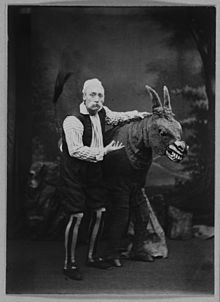Pantomime horse

Apantomime horseis atheatricalrepresentation of ahorseor otherquadrupedby twoactorsin a singlecostumewho cooperate and synchronize their movements.[1]One actor plays the front end, including the horse's head and its front legs, in a more-or-less upright posture and with a reasonable field of view afforded by eye holes in the horse's head.[1]The other actor, playing the rear end of the animal, must bend at the waist so that their torso is horizontal like that of a horse and put his arms around the waist of the first actor.[1]They can see little, although there are normally eye holes in the bottom part of the horse's torso to enable them to see where they are putting their feet and to enable them to breathe.
Pantomime horses and cows feature in Christmaspantomimes,mainly in theUnited Kingdom.
History
[edit]The progenitors of the pantomime horse costume were thecentaurand theass,costumes used inancient GreekandRomanrevels,which carried on tocommedia dell'arteshows.[2]However, the two-person comic variant of the horse or donkey costume was introduced in the late 19th century. It remained popular throughout the mid-20th century, becoming an "icon of comedy" that entered into the British imagination and the English language.[2]
The "grandfather" of the modern pantomime horse was the Blondin Donkey, introduced at the Royal Holborn theatre in 1885 by the acrobatic Griffiths brothers, Fred and Joe, and named after thetightrope walkerwho was famous for crossingNiagara Falls.[2]A different horse known as Pogo the Performing Horse and worn by a father-and-son team became a popular panto feature and appeared at theLondon Coliseumin 1923.[2]
British character actor,Colin Gordonbegan his stage career as the back end of a pantomime horse in a 1934 production of "Toad of Toad Hall".[3]
Types
[edit]Panto horse costumes range from low-cost, "ready-to-wear" fabric versions to more complex puppet suits that have moving features operated with special wires from within.[2]The most basic costumes have a sheet-like body that is draped over the wearers, while professional costumes have a closed body that often contains a padded frame to conform it to a certain shape. These costumes usually separate into two halves with a sealable seam down the middle of the body.
Other types of similar costumes include pantomimecows,zebras,andcamels.[1]Many modern-day pantomime horses are used in charity "horse" races,[2]such as the London Pantomime Horse Race inGreenwich, London,an annual world-famous race-day event.[4]
In pop culture
[edit]This sectionneeds additional citations forverification.(March 2018) |

Pantomime horses and pantomime cows feature in Christmaspantomimes,mainly in theUnited Kingdom.A skilled pair of performers can dance as a pantomime horse. Pantomime horses feature prominently in an episode ofMonty Python's Flying Circustitled "Blood, Devastation, Death, War and Horror".In the" Merchant Banker "sketch, two pantomime horses are forced to fight to the death for their job. Another sketch features a pantomime horse as aJames Bond-esque secret agent, chasing its enemy around the world in cars, rickshaws, and even riding actual horses. The episode also features a pantomime goose and apantomime damePrincess Margaret,which later appeared in the video for the George Harrison song "Crackerbox Palace".
A song on British pop groupSuede'seponymous debut albumis called "Pantomime Horse".
The American late-night talk-show hostCraig Fergusonhas a recurring sketch with a pantomime horse named afterSecretariatthat originally appeared every time a doorbell rang, accompanied by a frenzied dance performed by onlookers who rapidly and repeatedly extend their arms. The horse first appeared on October 11, 2010. When the program moved to a new studio, an on-set stable was built for Secretariat. Thispantomime Secretariathas begun to appear on other CBS programs.[citation needed]
See also
[edit]References
[edit]- ^abcdWard, Andrew (2017). "The Panto Horse Derby".Horse Racing's Strangest Tales.La Vergne: Pavilion Books.ISBN978-1911042839.OCLC973187432.
- ^abcdefMusson, Jeremy (2003).History of the Pantomime Horse.Vol. 197. Country Life, Limited. pp. 98–100.
{{cite book}}:|work=ignored (help) - ^https://www.imdb.com/name/nm0330101/[user-generated source]
- ^Ratcliffe, Chris J. (16 December 2018)."Pantomime horses race from pub to pub in Greenwich – in pictures".The Guardian.Retrieved16 September2021.
